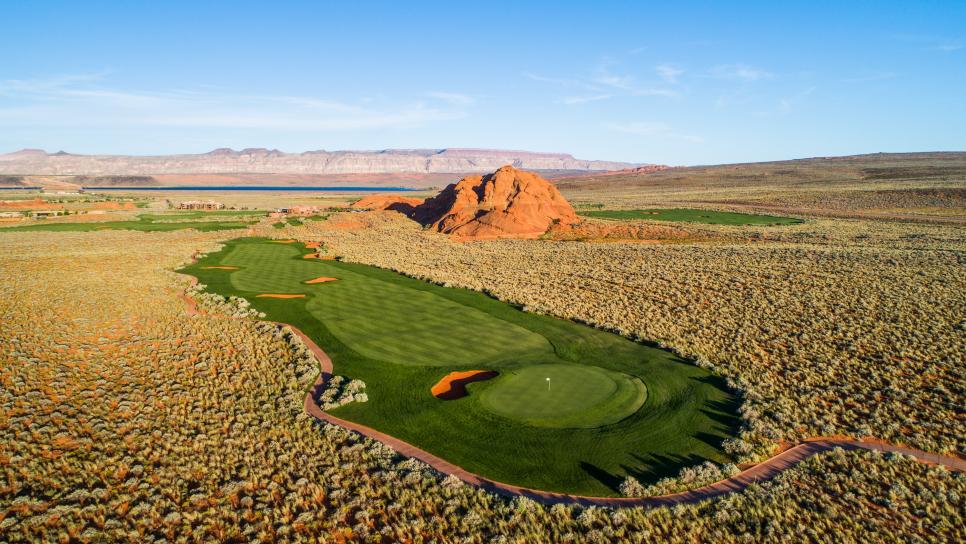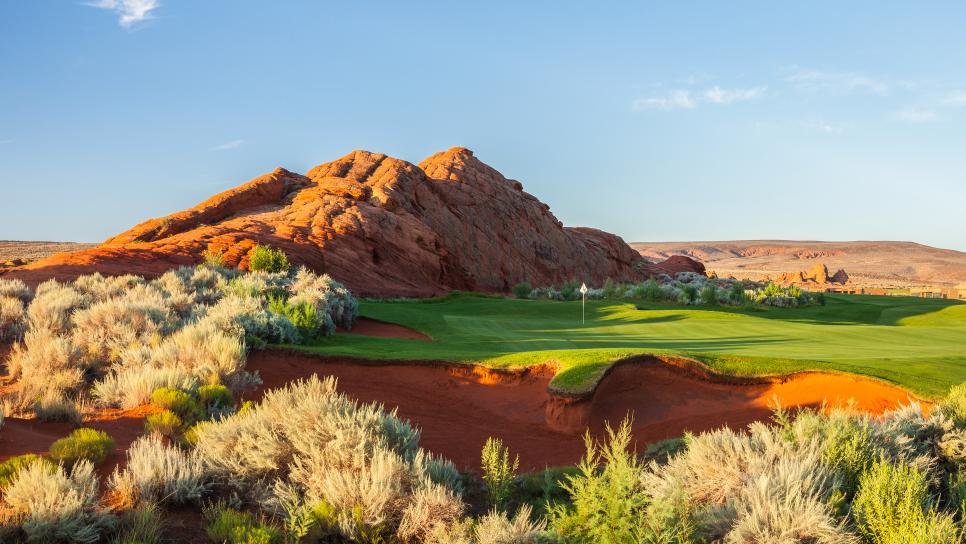Bandon Dunes and Central Wisconsin aren't the only enormous sand boxes of golf in America. In the southwest corner of Utah, in the shadow of Zion National Park, lies a sandbelt of rich, red, pulverized silica atop which half a dozen four-star golf courses have blossomed in the past quarter-century.
This is where a seam of the earth's core once erupted in tremendous fury, before morphing into a glorious skyline of twisted, tilted towers of red rock and canyons of sandstone, their walls streaked with broad strokes of rust, umber and salmon, certain strata bleached white by saturated rain. The softest layers crumbled and eroded over time into a high desert of dunes and hollows so porous as to forgo the need for drainpipe beneath fairways and greens. The tandem communities of St. George, Washington City and Hurricane (pronounced Hur-a-kin) have served as a plentiful palette for a number of course architects, most of them from Southern California or Phoenix and well-versed in dealing with desert motifs.
THE SKYLINE FEATURES TWISTED, TILTED TOWERS OF RED ROCK AND CANYONS OF SANDSTONE.
The oldest courses are Dixie Red Hills, a delightful nine-holer tucked in a box canyon, and Green Spring, a municipal that opened in 1989 with an exhibition by Johnny Miller, a BYU grad and the state's most famous tour pro. The highlight of this Gene Bates layout are the par-3 fifth and par-4 sixth, both demanding approach shots over a ragged arroyo of jagged rock. The remainder of the course is well developed with homes now, although there are still views of painted desert from many spots.
Other courses, like Sunbrook and Entrada at Snow Canyon (the latter a Johnny Miller "signature design" done with Fred Bliss) seem to be mere transplants from Palm Springs or Scottsdale, with palm trees and waterscapes. But both of these incorporate dry washes in their architecture and contain surprising stretches than run through black-lava beds. Of the two, Entrada's back-nine triangle of lava-edged holes is far more stark, unbridled and intimidating, particularly when the wind blows, which is most days.
The aptly named Coral Canyon sits below the horizon amid rocks that are various shades of pink. A Keith Foster design, it opens with back-to-back par 5s, but its biggest thrills involve two great short holes, the pitch-shot par-3 sixth, where a tiny green is surrounded by boulders and chunks of rock, and the drivable par-4 eighth, tantalizing at 312 yards from the tips, 263 from the regular tees, with a gulch hard left. Seemingly neglected in recent years, Coral Canyon has a new owner and a new spirit.

Brian G. Oar - Fairways Photography
Just southeast of Coral Canyon is the area's true destination design, Sand Hollow Resort, 27 holes by John Fought, a former U.S. Amateur champion and two-time winner on the PGA Tour. (Golf architect Andy Staples served as project manager.) The front nine of its Championship 18 drifts through high-plains sagebrush and around massive outcroppings, with many moguls in the fairways and more moguls in the greens. The vistas are an engulfing panorama of rock formations and mountain ranges but are soon forgotten on the back nine. To step on the 11th tee is to step on the edge of the world. Beyond the butte-top green on this downhill par 3 is a vast gorge many miles across. Along its leading edge are the next four holes, positioned in near-acrophobic fashion, a drop of some 100 feet or more along the left of each hole to canyon bottom, with high cliff walls on the right of three of the four. The topography along this edge was the perfect dimension for golf holes, Fought told us, necessitating just the fill of one minor gulley that slashed across what is now the 12th fairway.
SOUTHERN UTAH IS A GOLF MECCA THAT HAS YET TO BE FULLY EXPLORED.
The short par-4 13th fits naturally if snugly atop a ledge (the only fairway where carts aren't allowed), and the downhill, sidehill par-4 14th offers the sensation of hurtling down a bobsled run. Sand Hollow's final rimshot is the 15th, 230 yards from a low back tee, acceptable if you can thread a wood between rock monoliths, but more manageable from the elevated regular tees to the right, though still a cliffhanger with little room for error around the green.

Brian G. Oar - Fairways Photography
The final three playing inland are not anticlimactic, particularly because the par-5 17th features a genuine Hell's Half Acre cross hazard of desert. On the far side of the practice range is a third nine, The Links, more rustic in appearance and upkeep but equally compelling, with long, linear walls of stacked lava intersecting holes and a par-4 fifth expertly patterned after the famed Road Hole of the Old Course at St. Andrews.

Brian G. Oar - Fairways Photography
Southern Utah is a golf mecca that has yet to be fully explored. The high altitude provides for thinner air, drier conditions and lots of carry and fairway roll. The area is playable much of the winter, and the prices are a fraction of Phoenix or Vegas. What's more, that glorious backdrop of slanted rock that stretches across the horizon of every course is called the Pine Valley Mountains. Now that's golf.


